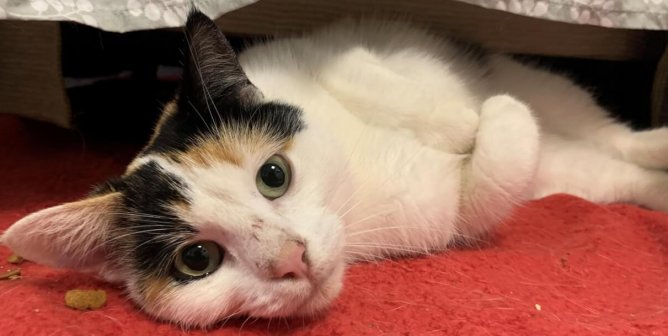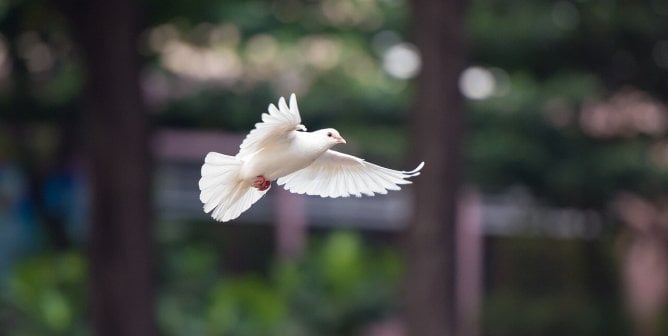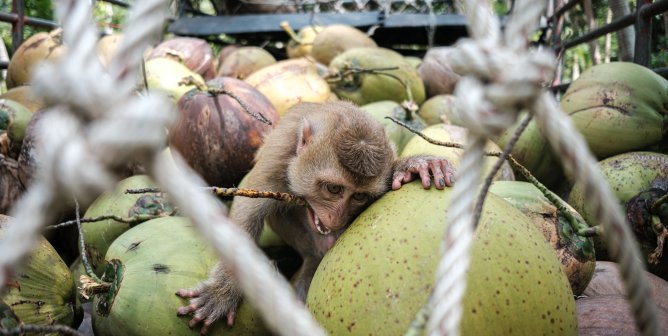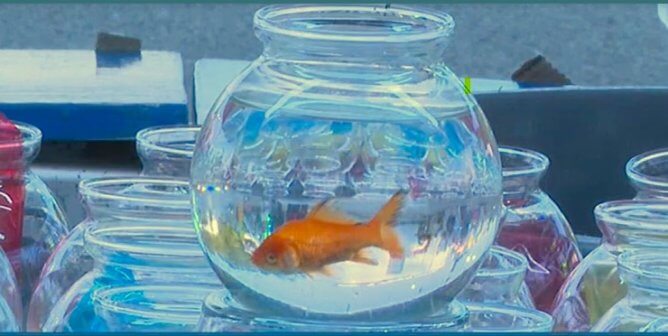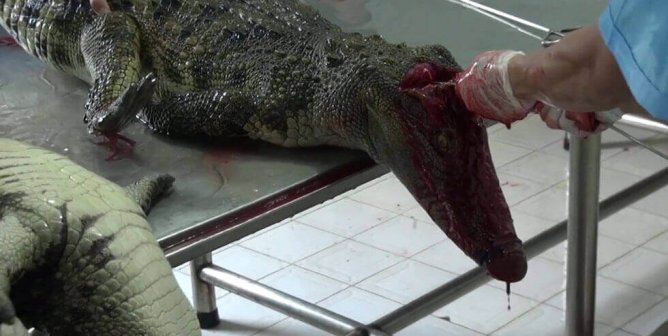Zoos: Pitiful Prisons
Despite their professed concern for animals, zoos can more accurately be described as “collections” of interesting animals than as actual havens or homes. Even under the best of circumstances at the best of zoos, captivity cannot begin to replicate wild animals’ habitats. Animals are often prevented from doing most of the things that are natural and important to them, like running, roaming, flying, climbing, foraging, choosing a partner, and being with others of their own kind. Zoos teach people that it is acceptable to interfere with animals and keep them locked up in captivity, where they are bored, cramped, lonely, deprived of all control over their lives, and far from their natural homes.
Virginia McKenna, who starred in the classic movie Born Free and received an Order of the British Empire in 2003 for her work in behalf of captive animals, says that her participation in Born Free made her realize that “wild animals belonged in the wild, not imprisoned in zoos. … Freedom is a precious concept, and wild animals suffer physically and mentally from the lack of freedom captivity imposes.”1
Little Investment in Animal Care
Zoos vary in size and quality—from drive-through parks to small roadside menageries with concrete slabs and iron bars. Millions of people visit zoos annually, but most zoos operate at a loss and must find ways to cut costs or add gimmicks that will attract visitors.2 The Wall Street Journal reported in 2003 that “nearly half of the country’s zoos are facing cutbacks this year … [a]ttendance, meanwhile, is down about 3% nationwide.”3 Precious funds that should be used to provide more humane conditions for animals are often squandered on cosmetic improvements—such as landscaping, refreshment stands, and gift shops—in order to draw visitors.
Ultimately, animals—and sometimes visitors—are the ones who pay the price. Tatiana, a Siberian tiger, escaped her substandard enclosure at the San Francisco Zoo in 2007 and was shot to death after she killed one person and injured two others; she had mauled one of the zookeepers a year earlier.4 A gorilla named Jabari tried to escape from the Dallas Zoo by jumping over walls and moats and evading electrified wires, only to be fatally shot by police; a witness later reported that teenagers were taunting the animal with rocks prior to his escape.5 In the summer of 2005, two polar bears died within five weeks of each other at the Saint Louis Zoo—Churchill died after ingesting an object that had been thrown into his exhibit, and Penny died from an infection as a result of having two dead fetuses in her uterus.6 At the Virginia Zoo, 10 prairie dogs died when their tunnel collapsed, a rhinoceros drowned in the moat of her exhibit, and a zebra narrowly escaped death after jumping into the lion exhibit, while another lost her life when she bolted from a holding pen, struck a fence, and broke her neck.7,8
Entertainment, Not Education
Zoos claim to provide educational opportunities, but most visitors spend only a few minutes at each display, seeking entertainment rather than enlightenment. Over the course of five summers, a curator at the National Zoo followed more than 700 zoo visitors and found that “it didn’t matter what was on display … people [were] treating the exhibits like wallpaper.” He determined that “officials should stop kidding themselves about the tremendous educational value of showing an animal behind a glass wall.”9
Most zoo enclosures are very small, and rather than promoting respect for or understanding of animals, signs often provide little more information than an animal’s species, diet, and natural range. Animals’ normal behavior is seldom discussed, much less observed, because their natural needs are rarely met. Birds’ wings may be clipped so that they cannot fly, aquatic animals often go without adequate water, and many animals who naturally live in large herds or family groups are kept alone or, at most, in pairs. Natural hunting and mating behaviors are virtually eliminated by regulated feeding and breeding regimens. Animals are closely confined, lack privacy, and have little opportunity for mental stimulation or physical exercise. These conditions often result in abnormal and self-destructive behavior, known as “zoochosis.”
An Oxford University study based on four decades of observing animals in captivity and in the wild found that animals such as polar bears, lions, tigers, and cheetahs “show the most evidence of stress and/or psychological dysfunction in captivity” and concluded that “the keeping of naturally wide-ranging carnivores should be either fundamentally improved or phased out.”10,11 A survey of the records of 4,500 elephants both in the wild and in captivity found that the median life span for an African elephant in a zoo was 16.9 years, whereas African elephants on a nature preserve died of natural causes at a median age of 56 years. Researchers concluded that “bringing elephants into zoos profoundly impairs their viability.”12
A PETA investigation of numerous zoos across the country found several bear species exhibiting neurotic, stereotypic behaviors. These frustrated animals spend much of their time pacing, walking in tight circles, swaying or rolling their heads, and showing other signs of psychological distress. In some bear enclosures, paths worn by the bears’ constant pacing could be seen; in others, there were actual paw impressions in the soil where bears had repeatedly stepped in the exact same spot. This behavior is symptomatic of not just boredom but also profound despondency.
Propagation, Not Preservation
Zoos claim to want to protect species from extinction, which sounds like a noble goal, but zoo officials usually favor exotic or popular animals—who draw crowds and publicity—rather than threatened or endangered local wildlife. The Chinese government, for example, “rents” pandas to zoos worldwide for fees of more than $1 million per year, but some question whether the profits are being directed toward panda-conservation efforts at all.13 Most animals housed in zoos are not endangered, and those who are will likely never be released into natural habitats.
The purpose of most zoos’ research is to find ways to breed and maintain more animals in captivity. If zoos ceased to exist, so would the “need” for most of their research.
Born Free, Sold Out
Zoos continue to capture animals from the wild to put them on public display. In 2016, the US Fish and Wildlife Service approved the capture and transfer of 18 African elephants, a species designated as threatened, from their natural habitats in Swaziland to zoos in Kansas, Nebraska and Texas.14 Experts, scientists, and researchers who study elephants in the wild strongly opposed a similar capture in 2003, stating, “Taking elephants from the wild is not only traumatic for them, it is also detrimental to their health. … [W]e believe the time has come to consider them as sentient beings and not as so much money on the hoof to be captured and sold and displayed for our own use.”15
Zoos are also pressuring the federal government to weaken the Endangered Species Act to make it easier for them to capture and import animals.
When Cute Little Babies Grow Up
Zoo babies are crowd-pleasers, but breeding programs—under the guise of species preservation—inevitably result in a surplus of less “cute” adult animals. Zoos routinely trade, loan, sell, or barter adult animals they no longer want.
A chimpanzee named Edith is one example of a discarded zoo baby who fell into the wrong hands. Born in the 1960s at the Saint Louis Zoo, Edith was surely a big draw for visitors. But just after her third birthday, she was taken from her family and passed around to at least five different facilities, finally landing at a Texas roadside zoo called the Amarillo Wildlife Refuge (AWR). During an undercover investigation of AWR, PETA found Edith in a filthy, barren concrete pit. She was hairless and had been living on rotten produce and dog food.
Twiggs and Jeffrey, two giraffes born at the Cape May County Zoo in New Jersey, were sold by the zoo to a broker who subsequently sold them to a traveling circus.16The director of the Cape May County Zoo actually admitted to seeing the animals’ pitiful living conditions in the circus but did not do anything to alleviate their suffering or improve their situation.
Zoos across the country sold animals to the now-closed New Braunfels Zoo in Texas and continued to do so even after one of its employees “quit in disgust at the animal neglect.”17 The director of an Arizona zoo sold several exotic goats to a dealer who was known to supply animals to trophy-hunting ranches.18
Hope for Animals
After recognizing that they could not adequately provide for the complex needs of elephants, several zoos have made the decision to close their elephant exhibits, setting a positive precedent for zoos worldwide. The Detroit Zoo sent two elephants to a sanctuary because, in the words of the zoo’s director, “Just as polar bears don’t thrive in hot climates, Asian elephants should not live in small groups without many acres to roam. They clearly shouldn’t have to suffer winters of the North.”19
The Baltimore Zoo, Detroit Zoo, Point Defiance Zoo and Aquarium, North Carolina Zoo, and others have taken in polar bears who were rescued from a tropical circus, but progressive zoos like these are the exception rather than the rule.
Beyond Zoos
Ultimately, endangered species will only be saved by preserving their habitats and combating the reasons they are killed by people. Instead of patronizing zoos, it is better to support groups like the International Primate Protection League, the Born Free Foundation, Earth Island Institute, and other groups that work to preserve habitats. Nonprofit sanctuaries that are accredited by the Global Federation of Animal Sanctuaries, such as The Elephant Sanctuary and the Performing Animal Welfare Society, also deserve the public’s support. These sanctuaries rescue and care for exotic animals without selling or breeding them.
With informative television programming, educational opportunities on the Internet, and the relative ease of international travel, learning about or viewing animals in their natural habitats can be as simple as a flick of a switch or a hike up a mountain. The idea of keeping animals confined behind cage bars is obsolete.
What You Can Do
Never patronize zoos. The money spent on ticket purchases pays for animals to be imprisoned and traded, not rescued and rehabilitated.
If your local zoo solicits money from corporate donors and/or charitable organizations and foundations, write to the zoo’s sponsors and encourage them to put their money toward protecting animals in the wild instead.
Zoos are covered by the federal Animal Welfare Act (AWA), which sets minimal housing and maintenance standards for captive animals. The AWA requires that all animal displays be licensed with the U.S. Department of Agriculture, which must inspect zoos once a year. However, some zoos that have passed USDA inspections with flying colors have later been found by humane groups to have numerous violations. Read Beyond the Bars, edited by Virginia McKenna, Will Travers, and Jonathan Wray, for more information.
Encourage your local zoo to stop breeding animals, to pledge never to accept any animals captured from the wild, and to make space available for rescued exotic animals in need of a permanent home. Report poor conditions to the USDA, leaflet at the zoo, write letters to the editor, and pressure local officials to stop subsidizing zoos with taxpayer money.
References
1BBC News, “Born Free Star McKenna Honoured,” 31 Dec. 2003.
2Michael Satchell, “Cruel and Usual: How Some of America’s Best Zoos Get Rid of Their Old, Infirm, and Unwanted Animals,” U.S. News and World Report 5 Aug. 2002.
3Brooks Barnes, “Outings: A Bear Market for Zoos,” The Wall Street Journal 30 May 2003.
4Patricia Yollin et al., “S.F. Zoo Visitor Saw 2 Victims of Tiger Attack Teasing Lions,” San Francisco Chronicle 1 Jan. 2008.
5Mary Mckee and Eva-Marie Ayala, “2 Teens Taunted Gorilla, Zoo Says,” Fort Worth Star-Telegram 23 Mar. 2004.
6Todd C. Frankel, “Zoo Suffers 2nd Polar Bear Death in 5 Weeks,” St. Louis Post-Dispatch 2 Jul. 2005.
7Debbie Messina, “Tunnel Collapse Apparently Wipes Out Zoo’s Prairie Dogs,” The Virginian-Pilot 23 Dec. 2005.
8Debbie Messina, “Zebra Dies at Virginia Zoo After Getting Its Rabies Shot,” The Virginian-Pilot 1 Nov. 2006.
9William Booth, “Naked Ape New Zoo Attraction; Surprise Results From People-Watching Study,” The Washington Post 14 Mar. 1991
10Mark Derr, “Big Beasts, Tight Space and a Call for Change in Journal Report,” The New York Times 2 Oct. 2003.
11Ros Clubb and Georgia Mason, “Captivity Effects on Wide-Ranging Carnivores,” Nature 2 Oct. 2003.
12Ross Clubb et al., “Compromised Survivorship in Zoo Elephants,” Science 322 (2008): 1649.
13“Critics Question China’s Worldwide Panda Profit,” The Age 5 Apr. 2003.
14Christine Hauser,”18 Elephants on a Plane: Move From Swaziland to U.S. Is Criticized,” The New York Times 2 Feb. 2016.
15Amboseli Elephant Research Project, letter to U.S. Fish and Wildlife Service, 24 Jun. 2003.
16Amy S. Rosenberg, “What Kind of Life Do Giraffes Prefer? Irascible at the Cape May Count Zoo, Happy in the Circus,” Philadelphia Inquirer 5 Aug. 2001.
17Satchell.
18Satchell.
19Detroit Zoological Institute, “Detroit Zoo Intends to Send Elephants to Elephant Sanctuary,” PR Newswire, 20 May 2004.
